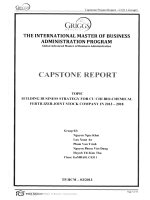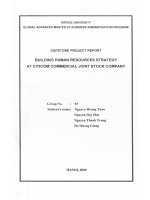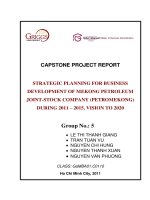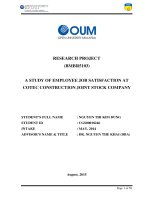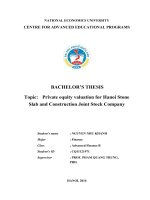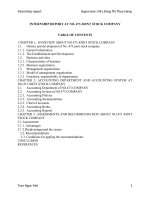ACCOUNTING FOR FIXED ASSETS AT AVIATION PRINTING JOINT STOCK COMPANY
Bạn đang xem bản rút gọn của tài liệu. Xem và tải ngay bản đầy đủ của tài liệu tại đây (607.51 KB, 67 trang )
1
NATIONAL ECONOMICS UNIVERSITY
CENTER FOR ADVANCED EDUCATIONAL PROGRAMS
*****************************
BACHELOR’S THESIS IN
ACCOUNTING
ACCOUNTING FOR FIXED ASSETS AT
AVIATION PRINTING JOINT STOCK COMPANY
Student’s name
ID
Class
Intake
Internship guide
Instructor
: Tran Thuy Tien
: 11123956
: Advanced Accounting
: 54B
: Dr. Pham Duc Cuong
:
Hanoi - 2016
M\\\\\\\\\\\\\\\\\\\\\\\\\\\\\\\\\\\\\\\\\\\\\\\\\\\\\\\\\\\\\\\\\\\\\\\\\\\\\\\\\\\\\\\\\\\\\\\\\\\\\\\\\\\\\\\\\\\\\\
2
3
ACKNOWLEDGEMENTS
During the time practicing as an intern at Aviation Printing Joint Stock
Company, it is my honor to say that after three months working at here, from
January 15th to April 15th 2015, I have taken a huge opportunity being exposed into
such a highly professional working environment. People staffed at Aviation Printing
Joint Stock Company treated me with the respect as colleagues even I was not an
official staff. I found the occasion to acknowledge more about characteristics of
accounting in practice, while applying the knowledge I have learned at university
by the best way during the internship.
Special thanks go to Dr. Pham Duc Cuong, lecturer at the School of
Accounting and Auditing, National Economics University and colleagues in
accounting department of AVIPRINT., JSC for their patience, helpful and
enthusiastic guidance for me in completing this report.
Student,
Tran Thuy Tien
4
TABLE OF CONTENTS
ACKNOWLEDGEMENTS
INTRODUCTION
CHAPTER 1: THEORETICAL ACCOUNTING FRAMEWORK FOR FIXED
ASSETS
1.1. Overview of Fixed Assets
1.1.1. Characteristics and classification of fixed assets
1.1.2. Management and usage of fixed assets
1.2. Vietnamese Accounting Regulation on increases and decreases of fixed assets
1.2.1. Determination of cost for fixed assets
1.2.2. Accounting for fixed assets at subledger level
1.2.3. General Accounting for increase, decrease in fixed assets
1.3. Accounting for depreciation of fixed assets
1.3.1. Methods for depreciation of fixed assets
1.3.2. Principles for depreciation of fixed assets
1.4. Accounting for maintenance and repair of fixed assets
1.5. Comparison of VAS and IAS and fixed assets
1.5.1. International accounting for fixed assets
1.5.2. Similarities and differences between VAS and IAS for fixed assets
CHAPTER 2: CURRENT SITUATION OF ACCOUNTING FOR FIXED
ASSETS AT AVIATION PRINTING JOINT STOCK COMPANY
2.1. Overview of Fixed Assets at AVIPRINT., JSC
2.1.1. Characteristics and classification of fixed assets
2.1.2. Management and usage of fixed assets
2.2. Accounting application for increases and decreases of fixed assets at
AVIPRINT., JSC
2.2.1. Accounting documents and procedures
2.2.1. Accounting for increase of fixed assets at subledger level
5
2.2.3. General Accounting for increase of fixed assets
2.3. Accounting application for decreases of fixed assets at AVIPRINT., JSC
2.3.1. Accounting documents and procedures
2.3.2. Accounting for decrease of fixed assets at subledger level
2.3.3. General Accounting for decrease of fixed assets
2.4. Accounting application for depreciation of fixed assets at AVIPRINT., JSC
2.5. Accounting application for maintenance and repair of fixed assets at
AVIPRINT., JSC
CHAPTER 3: DISCUSIONS AND RECOMMENDATIONS ON
ACCOUNTING FOR FIXED ASSETS AT AVIATION PRINTING JOINT
STOCK COMPANY
3.1. Discussions on accounting for fixed assets at AVIPRINT., JSC
3.1.1. Advantages of accounting for fixed assets at AVIPRINT., JSC
3.1.2. Disadvantages of accounting for fixed assets at AVIPRINT., JSC
4.2. Recommendations on accounting for fixed assets at AVIPRINT., JSC
CONCLUSIONS ON ACCOUNTING FOR FIXED ASSETS AT AVIATION
PRINTING JOINT STOCK COMPANY
REFERENCES
APPENDIXES
6
STATUTORY DECLARATION
I herewith formally declare that I myself have written the submitted
Bachelor’s Thesis independently. I did not use any outside support except the
quoted literature and other sources mentioned at the end of this paper.
Hanoi, 04/06/2016
Signature
7
ABBREVIATIONS
Acc
: Account
IAS
: International Accounting Systems
JV
: Journal- Vouchers
LLC
: Limited Liability Company
VAS
: Vietnamese Accounting Systems
8
LIST OF TABLES
9
LIST OF FIGURES
10
CHAPTER 1
INTRODUCTION
Rationale
In recent years, "Industrialization - Modernizing" is conducted broadly and
comprehensively in Vietnam, scale of the building keeps an essential position in the
country development in the recent years, together with national manufacturing and
economic development are being carried out rapidly, as it creates "living skeletons"
- the basis for the foundation of the national economy. Manufacturing activity is
essentially the use of labor means to impact on the object of labor to create products
that serve the needs of humans. Entering the market economy, many businesses
might tackle a bunch of struggles, for instance, facing bankruptcy as they could not
match the consumers' demand and production does not keep the market rising
speed. As a result, technical innovation and product quality development to fit the
growing demands of society are needed. As from the beginning, fixed assets play an
integral in the infrastructure of the national economy, thus it is an important element
of the process of social production. With companies, fixed assets factor is
technology, business and production capacity. Fixed assets therefore are seen as a
measure of the level of technology, production capacity and competitiveness of
companies. For every company in general and particularly Aviation Printing Joint
Stock Company, it is significant not just to scale fixed assets but also to effectively
exploit available fixed asset resources.
11
Research objectives
The thesis is about accounting for fixed assets at AVIPRINT., JSC - the base
to realize advantages and disadvantages, which affect the effectiveness of
production. As a result, the company can overcome these shortcomings and create a
management regime to ensure rational use of fixed assets capacity combined with
the frequent renewal fixed assets, completing the accounting for fixed assets.
Research methodology
•
Contents:
-
General reasoning of fixed assets on accounting in business and
comparison between VAS and IAS.
-
Current situation of accounting for fixed asset at AVIPRINT., JSC.
-
Discussion and recommendations to improve the efficiency, management
and complete the work of accounting for fixed assets.
•
Methodology:
-
Sources of data collection:
+ Primary data: Through observation and case studies given at the
AVIPRINT., JSC.
+ Secondary data: Most of the data come from secondary source, which
include AVIPRINT., JSC’s annual reports , Vietnamese accounting systems,
Principles of financial accounting textbook, Circular 45/2013 / TT-BTC- guiding
the management, use and depreciation of fixed assets, Decision 200/2015/QĐ-BTC
and online websites: Aviation Printing Joint Stock Company and VNDIRECT
Securities Corporation.
-
Types of research methodology:
Documents are collected fully, uninterrupted and unified from 2013 to 2015
shown in the financial statements, accounting vouchers, and other related
accounting documents. The data then will be analyzed and discussed within the
company’s situation, thus coming out the conclusion and recommendation for better
accounting management and further research.
12
-
The report is also applied other fundamental approaches to collect data:
Qualitative research: It is collecting and analyzing information by observing
people’s activities. Qualitative research refers to the meanings, definitions,
characteristics, symbols, metaphors, and description of things.
Quantitative research: It is based on numeric figures or numbers, aims to
measure the quantity or amount and compares it with past records and tries to
project for future period. The objective of quantitative research is to develop and
employ mathematical models, theories or hypothesis pertaining to phenomena.
-
Data processing methods:
Due to the nature of these styles of research, statistics is the most widely
used branch of this research. Furthermore, some of common methods are used
extensively with in fields, for instance, synthetic material facts analysis, combining
theoretical and practical studies, aggregate statistical analysis.
Scope of research
The thesis concentrated on analyzing the current situation of management,
usage and changes in the accounting profession of fixed assets in Aviation Printing
Joint Stock Company in recent years, including accounting application for
increases, decreases, depreciation and maintenance and repair of fixed assets under
regulations by Circular 200/2014/TT-BTC.
Research structure
Six main components of the report content are shown below:
-
Acknowledgements
Introduction
Chapter 1: Theoretical accounting framework about for fixed assets
Chapter 2: Current situation accounting for fixed assets at Aviation
-
Printing Joint Stock Company
Chapter 3: Discussions and recommendations on accounting for fixed
assets at Aviation Printing Joint Stock Company.
CHAPTER 1
THEORETICAL ACCOUNTING FRAMEWORK
13
FOR FIXED ASSETS
1.1. Overview of Fixed Assets
1.1.1. Characteristics and classification of fixed assets
A fixed asset is a long-term tangible piece of property that is owned and used
in the production by a firm of its income, not supposing to be consumed or
converted into cash for at least a year. Therefore, accountants use depreciation as a
way to allocate the costs of a fixed asset over the period in which the asset is
useable to the business. Full transaction is recorded by the bookkeeper when the
asset is purchased, but regularly is the asset’s value decreased by deducting a
portion of that value as a depreciation expense every year.
If one meets the following three factors, it shall be regarded as a fixed asset:
-
It is evident to gain economic benefit in the future from the use of such
-
asset.
Having the utilization time of over 01 year.
Primary price of assets must be determined reliably, and is valued at
30,000,000 dong or more.
In general, fixed assets classification is comprised of land, buildings and
factories, furniture, fixtures and equipment, intangible assets, machinery and
equipment, as well as leasehold improvements, manufacturing in progress, and
capital leases. It is the division of all fixed assets in the certain indicators in order to
cater to requirements of business management:
-1. Fixed assets used for business purposes are fixed assets managed and used by
enterprises for their business purposes.
+ For tangible fixed assets, the enterprises can classify them as follows:
Type 1: Buildings and architectures: are the enterprise’s fixed assets formed after
the manufacturing process, such as head office, warehousing, fences, water tower,
open storage, the works decorating housing, roads, bridges, railways, airfield, piers,
wharves, docks and slipway.
Type 2: Machinery and equipment: the whole machinery and equipment used in the
business operation of the enterprise such as specialized machinery, working
14
equipment, drilling rigs in the oil and gas area, cranes, technological lines and
individual machines.
Type 3: Means of transport, transmission equipment are types of means of
transportation including railway, water way, road, air, pipeline and transmission
equipment, such as information system, electrical system, water pipe and conveyor.
Type 4: Equipment and management tools: are the equipment and tools used in the
management of the enterprise’s business operations such as computers for
management, electronic equipment, equipment, measurement and quality tools,
dehumidifiers, vacuum cleaners, anti-termite.
Type 5: Perennial orchards, working animals and / or giving products: are the
perennial orchards as coffee plantations, tea plantations, rubber plantations,
orchards, lawn, green carpet ..., working animals and / or giving products, such as
herd of elephants, horses, buffaloes, cows ...
Type 6: Other types of fixed assets: are all other fixed assets not listed in the above
five types such as pictures,.
+ Intangible fixed assets: issuance right, patent, inventions, literature, works of art,
science, products, results of art performance, video and audio recordings,
broadcasting programs, satellite signals carrying coded programs, industrial
designs, designs of semiconductor integrated circuits, business secrets, trademarks,
trade names and geographical indications, plant varieties and breeding material.
-2. Fixed assets used for welfare purposes, career, security and national defense are
the fixed assets managed and used by enterprises for welfare purposes, career,
security and national defense in the enterprises. These fixed assets are also
classified under provisions of Point 1 mentioned above.
-3. Fixed assets preserved, kept or stored are the fixed assets which the enterprises
preserve or keep for other units or keep for the State as prescribed by the competent
State agencies.
-4. Depending on the requirements on management of each enterprise, the
enterprises shall classify more detailed their types of fixed asset in each group
accordingly.
15
Classification of fixed assets to help businesses apply the appropriate method
for each type of asset administration, thereby improving asset management
efficiency. There are many different ways to classify and amortization based on
different criteria.
1.1.2. Management and usage of fixed assets
Degree of equipped fixed assets is one of the manifestations of the
production scale of companies. All manufacturing companies in all economic
sectors have autonomy in the procurement and innovation of fixed assets and
liquidating fixed assets upon maturity. Thus, the structure and size of fixed assets
usually face volatility. In order for companies to meet the requirements of
management, fixed assets accounting must perform the following tasks:
- Every fixed asset takes an original file, containing an accounting one
managed by the accounting department and a technical one belonged to the IT
department. The accounting record comprises all the documents linked to fixed
assets from the time it is put into business to the day of liquidation, transfer ... these
vouchers are basis for recording fixed assets. Fixed assets upon receipt must be held
consoles, making delivery and testing records by the company.
- Companies store fixed assets at the office, works, warehouses or private
corporate sectors. All fixed assets taken to operation in the works needs either a
contract or a license. Each company has a department specialized security
management of fixed assets.
- Fixed assets’ depreciation need strictly reflecting during processing,
distribution, or calculating the exact transfer of depreciation to the costs of business.
Fixed assets have a plan of maintenance and repair, together with the cost
estimation. Companies are required to accurately reflect the actual cost of repair and
supervise the implementation of the process.
- Fixed assets are merely revaluated in the following events:
+ Inventory revaluation of fixed assets in accordance with the State's
decision
16
+ Equalization, diversified forms of ownership
+ Usage of assets to joint ventures, equity contributions
+ Adjustment to ensure real value of business fixed assets
Inventory and assets evaluation complies with the provisions of the State.
The increase or decrease in the value of assets must be accounted in accordance
with current regulations.
Company depreciates fixed assets under Circular 45/2013/ TT-BTC- guiding
the management, use and depreciation of fixed assets.
1.2. Vietnamese accounting regulation on increases and decreases of fixed
assets
1.2.1. Determination of cost for fixed assets
Each fixed asset must be managed by its primary price, accumulated depreciation
and residual value in accounting books.
History cost
Book value
=
-
Accumulated
depreciation of fixed
assets
The primary price of enterprise’s fixed assets is only changed in the following
cases:
- Re-evaluating the value of fixed assets in cases:
+ By decision of competent state authority.
+ Implementation of enterprise reorganization, enterprise ownership change,
enterprise transformation: split, merger, consolidation, equitization, sale, lease,
conversion of limited liability company into a joint stock company and from joint
stock company converted into a limited liability company.
+ Investment made outside enterprise by use of assets.
- Upgrading fixed assets
- Dismantling one or a number of parts of fixed assets but these parts are managed
by standard of a tangible fixed asset.
17
1.2.2. Accounting for fixed assets at subledger level
In the process used in production and business fixed assets, the value of fixed
assets wears out progressively and partially shifting in production and business
costs, although tangible assets remained initial physical forms until damaged. On
the other hand, fixed assets are used and stored in different parts of the business.
Thus, accountants have the rights to provide important indicators, like asset
structure, the allocation used by location, together with the preservation and usage
of fixed assets so as to spread accountability of physical preservation and usage of
fixed assets.
"Book of fixed assets" is used widely to monitor the fixed assets’ usage
managed by each unit. It recorded increases or decreases of fixed asset units on
each voucher, reduced amortization, according to chronological order of the
transactions.
Main contents of Accounting for fixed assets at sublegder level include:
- Prepare and collect the original documents relating to fixed assets in business
- Organize Accounting for fixed assets at sublegder level in the accounting
department
- Organize Accounting for fixed assets at sublegder level in the branch unit/
department used.
Accounting for fixed assets at subledger level is based on the original related
documents. Under current accounting regulations, the original documents are
below:
- Minutes of hand-over (Form 01)
- Fixed assets card (Form 02)
- Minutes of liquidation (Form 03)
- Minutes of complete overhaul (Form 04)
- Evaluation of fixed assets (Form 05)
- Registration, allocation spreadsheet of depreciation and amortization.
18
(*) In addition, transactions for fixed assets are related to a number of other
records such as: Fixed assets books for entire company or branch unit used,
technical documents, accounting records...
1.2.3. General Accounting for increase, decrease in fixed assets
Accounts 211 (Tangible fixed assets)
Account 211 has 6 sub-accounts:
- 2111: Buildings and architecture.
- 2112: Machinery and equipment.
- 2113: Means of transportation, transmission equipment.
- 2114: Management tools.
- 2118: Other tangible fixed assets
Debit
Acc 211
Credit
Reflecting the increase in tangible
Reflecting the decrease in tangible
fixed assets stated at cost
fixed assets stated at cost
(procurement, manufacturing and
(procurement, manufacturing and
allocation)
allocation...)
Balance: Tangible fixed assets
stated at cost.
Account 213 (Intangible fixed assets)
Account 213 has 6 sub-accounts:
- 2131: Land use rights
- 2132: The right arising
- 2133: Copyright, patent
- 2134: Trademarks
- 2135: Computer software
- 2136: Permits and franchise licenses
19
- 2138: Other intangible fixed assets
Debit
Acc 213
Credit
Cost of intangible fixed assets
Cost of intangible fixed assets
increase during the year
decrease during the year
Balance: Intangible fixed assets
Accounting for increase or decrease in fixed assets is according to the following
diagram:
20
Figure 1.1: Process of recording for increase, decrease in fixed assets
21
1.3. Accounting for depreciation of fixed assets
1.3.2 Methods for depreciation of fixed assets
a. Straight-line depreciation method
-
Content of the method:
The fixed assets in the companies are depreciated by the straight-line
depreciation method as follows:
+ Determining the annual average rate of depreciation for the fixed assets by
the following formula:
Original price of fixed assets
Annual average rate of
=
depreciation for fixed assets
Time of depreciation
+ Monthly average rate of depreciation equal to the yearly depreciation
divided by 12 months.
- In case the time of depreciation or the original price of the fixed assets
changes, the companies have to re-determine the average rate of depreciation of the
fixed assets by taking the Residual value in the accounting book divided by the time
of depreciation re-determined or remaining time of depreciation (determined as the
difference between the time of depreciation registered minus the time of
depreciation) of the fixed assets.
- The rate of depreciation for the final year of the time of depreciation of
fixed assets is determined as the difference between the primary price of fixed
assets and the accumulated depreciation made to the preceding year of the final year
of those fixed assets.
Determining the annual rate of depreciation (for the remaining years of fixed
assets) as follows:
Annual average rate of
depreciation of fixed
assets
Book value
=
Remaining time of depreciation of fixed
assets
The monthly average rate of depreciation equal to the yearly depreciation
22
deduction divided by 12 months.
b. Adjusted reducing balance method
-
Content of the method:
The rate of depreciation of fixed assets by this method is determined such as:
Determining the time of depreciation of fixed assets:
The companies shall determine the time of depreciation of fixed assets as
provided for in the Circular No 45/2013/TT-BTC of the Ministry of Finance.
Determining the time of depreciation of fixed assets:
The companies shall determine the time of depreciation of fixed assets as
provided for in the Circular No 45/2013/TT-BTC of the Ministry of Finance.
Determining the annual rate of depreciation of fixed assets in the years by
the following formula:
Annual rate of depreciation of
fixed assets
=
Book value
X
Accelerated
depreciation rate
The accelerated depreciation rate is determined by the following formula:
Accelerated
depreciation rate
(%)
Rate of depreciation by
=
Adjustment
X
straight-line method
coefficient
Rate of depreciation of fixed assets by the straight-line method is determined
as follows:
Rate of depreciation of fixed
assets by the straight-line
method (%)
1
=
Time of depreciation of
fixed assets
X 100
Adjustment coefficient is determined by the time of depreciation of fixed
assets specified in the following table:
23
Time of depreciation of fixed assets
Adjustment coefficient
(time)
Up to 4 years ( t < 4 years)
1,5
Over 4 to 6 years (4 years < t < 6 years)
2,0
Over 6 years (t > 6 years)
2,5
Table 1.1: Time of depreciation of fixed assets
For the last years, when the annual rate of depreciation determined by the
reducing balance method above mentioned is equal to (or lower) the average rate of
depreciation between the Residual value and remaining number of years of
utilization of fixed assets, then from that year, the rate of depreciation is calculated
by the Residual value of the fixed assets divided by the remaining number of years
of utilization of fixed assets.
The monthly rate of depreciation is equal to the yearly deducted depreciation
divided by 12 months.
c. Method of depreciation based on activities
-
Content of the method:
The fixed assets in companies are depreciated by this method as follows:
Based on the technical-economic records of the fixed assets, the companies
shall determine the total amount and volume of products made according to the
design capacity of fixed assets, referred to as the output by capacity design.
Based on the actual situation of production, the companies shall determine
the actual amount and volume of products made monthly, annually of the fixed
assets.
Determining the monthly rate of depreciation of fixed assets by the following
formula:
24
Monthly rate of
depreciation
=
of fixed assets
Amount of product
X
Monthly made
Average rate of
depreciation
for a unit of
product
In case the design capacity or primary price of fixed assets changes, the
companies shall re-determine the rate of depreciation of fixed assets.
1.3.2 Principles for depreciation of fixed assets
Account 214 (Accumulated depreciation)
Account 214 has 4 sub- accounts:
- 2141: Depreciation of tangible fixed assets
- 2142: Depreciation finance lease tangible fixed assets
- 2143: Depreciation of intangible fixed assets.
- 2147: Depreciation of investment property
Debit
Reflecting the decrease in
Acc 214
Credit
Reflecting the increase in
depreciation of fixed assets
(sale, liquidation)
depreciation of fixed assets
(extract amortization, increase
assessment)
Balance: Accumulated depreciation
of fixed assets
According to Circular 45/2013 / TT-BTC- guiding the management, use and
depreciation of fixed assets as follow:
All fixed assets of an companies must be depreciated, excluding the
following:
25
- Fixed assets which have been fully depreciated but are still used in
production and business activities.
- Lost fixed assets which have not yet been fully depreciated.
- Other fixed assets which are managed but not owned by the companies
(except financial leasing fixed assets).
- Fixed assets which are not managed monitored and included in the
enterprise's accounting books.
- Fixed assets used in welfare activities serving the enterprise's laborers
(excluding fixed assets serving laborers working in the companies, such as mid-shift
rest houses, mid-shift refectories, change houses, toilets, clean water tanks, garages,
healthcare rooms or clinics, vehicles transporting laborers to and from work, job
training establishments, laborers' houses built by the companies itself)- Fixed assets which are houses and residential land in case the companies
purchases houses and residential land for which land use rights have been allocated
by State to the companies for long-term use; depreciation costs are not required to
be calculated for the value of such land use rights.
- Fixed assets formed from non-refundable aid transferred by competent
agencies to the companies for scientific research purposes.
- Intangible fixed assets being land use rights.
Depreciation costs of fixed assets specified at Point 2.2, Section IV, Part C of
the Ministry of Finance's Circular No. 130/2008/TT-BTC of December 26, 2008,
guiding the implementation of a number of articles of Law No. 14/2008/QH12 on
Companies Income Tax, and guiding the implementation of the Government's
Decree No. 124/2008/ND-CP of December 11, 2008, detailing the implementation
of a number of articles of the Law on Companies Income Tax, are not allowed to be
included in reasonable expenses when calculating companies income tax.
For fixed assets which have not been fully depreciated and are irreparably
damaged, the companies shall identify causes and compensation responsibilities of
collectives or individuals at fault. Any difference between the book value of the
assets and the compensated sum of money and the recovered value (if any) shall be
